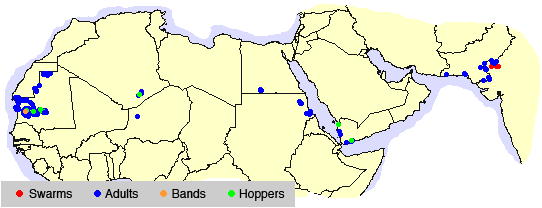22 December. Desert Locust outbreak develops locally on Eritrean Red Sea coast
A local outbreak has developed on the central Red Sea coast in Eritrea due to good rainfall and green vegetation. Solitarious and transiens hoppers and fledglings are forming small groups near Shieb and Shelshela agricultural areas, and adults are laying eggs. Breeding has also occurred in agricultural areas on the northern coast near Mehimet and the Sudanese border. Another generation of breeding is expected to occur which will cause locust numbers to increase. Four survey teams are monitoring the area and seven teams are undertaking control operations, having treated more than 4,000 ha since 9 December.
Ground control operations continue in the central Tamesna Plains of Niger against hoppers and adults that are forming small groups in response to drying vegetation.
Locust infestations continue to decline in northwest Mauritania and in Western Sahara where only small residual populations remain. Ground control operations were undertaken earlier this month against small hopper bands in both countries.
Small-scale breeding is in progress on the Red Sea coast in Sudan, mainly in the Tokar Delta. Scattered adults are present on the Red Sea coast of Yemen and along the coast of northwest Somalia. Small-scale breeding could occur in both countries due to good rains that recently fell.
OTHER LOCUSTS. Control operations are in progress against Brown Locust infestations in southwest Lesotho and Karoo, South Africa - the worst in many years. Control is also underway in southeast Zimbabwe against African Migratory Locust.

Control operations are underway in Eritrea, Niger and Mauritania.
4 December. Hoppers concentrate and form groups as vegetation dries out in W Africa
Ground control teams are treating small hopper bands that have formed in the past few weeks in northwest Mauritania and southern Western Sahara. During November, 900 ha were treated in Mauritania and 600 ha in Western Sahara. A field trial using a naturally-occurring fungus (Metarhizium) was also conducted in Mauritania. Limited infestations are expected to persist in both areas in the coming months. Although low temperatures will delay egg development and locust maturation, there is a slight risk of adults moving further north into northern Mauritania and to the Draa Valley in Morocco during periods of warm southerly winds.
Small groups of hoppers and adults are forming on the Tamesna Plains in Niger and in one area of northwest Mali. A few more small groups will form as vegetation continues to dry out in both countries. Niger treated 1,700 ha in November.
Small-scale breeding has started on the Red Sea coast of Sudan where hoppers are already present in the Tokar Delta. Breeding is also underway in other coastal areas of Sudan and Eritrea, and could occur in areas of recent rainfall on the Red Sea and Gulf of Aden coasts in Yemen. This should cause locust numbers to gradually increase in the region during the coming months.
The situation remains calm in Southwest Asia.
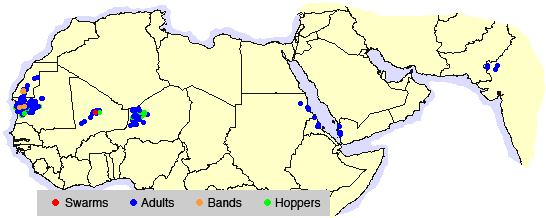
Small hopper bands are present in NW Mauritania and W Sahara; hopper groups are forming in Niger.
2 November. Small bands start forming in NW Mauritania
Small hopper groups and bands are forming in northwest Mauritania where an outbreak developed last month. Ground control teams have treated nearly 1,500 ha so far. A field trial using a biological control agent (Metarhizium) and helicopter surveys are in progress. So far, the outbreak is limited to Mauritania but there is a slight risk of adults moving north into northern Mauritania and Western Sahara where so far only low numbers of locusts are present. A few adults are present near Tombouctou, Mali. Small-scale breeding continues in Tamesna, Niger where a few small hopper groups are forming. Low numbers of adults are present along the Atbara River in northeast Sudan. Good rains fell along the Red Sea coastal plains in the past few days from Eritrea to Egypt and in Saudi Arabia. Scattered adults persist along the Indo-Pakistan border.
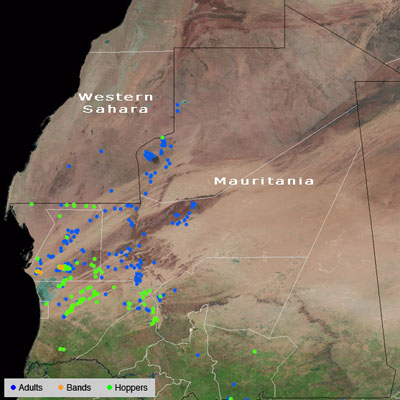
Small hopper bands are forming in NW Mauritania.
13 October. Hatching starts in NW Mauritania
An increasing number of mature adult groups of Desert Locust have been found in northwest Mauritania by ground teams since 5 October. So far, one small swarm was seen on the 9th near the coast about 125 km north of Nouakchott. Most of the adults were laying eggs that started hatching on 13 October. Ground teams started control operations on the 9th near Bennichab and, so far, nearly 450 ha have been treated. More survey teams are being mobilized to the northwest (Inchiri), the north (Adrar and Tiris Zemmour) and the centre (north of Aioun El Atrous) to check other areas where rains have fallen last month and where nomads have seen adult groups. Additional locusts are expected to appear and breed in northwest Mauritania during the remainder of October as vegetation dries out in the summer breeding areas in southern Mauritania.
In the past few days, no locusts have been seen in western Algeria near Tindouf nor in Western Sahara in the south near Tichla or in the centre near Guelta Zemmur.
FAO has sent funds to support these teams and is arranging for a helicopter to survey larger areas starting in about a week. Biopesticide field trials will be organized against the expected hopper infestations later this month.
The current level of resources in Mauritania should be sufficient to address the situation now. Whether external assistance will be needed will depend on how the situation develops during the next couple of months.
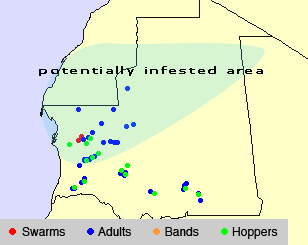
Most of the adults were laying eggs that started hatching on 13 October.
11 October. More locusts reported in NW Mauritania
An increasing number of mature adult groups of Desert Locust have been found in northwest Mauritania by ground teams since 5 October. So far, one small swarm was seen on the 9th near the coast about 125 km north of Nouakchott. Most of the adults were laying eggs. Hatching is expected to commence next week. Ground teams started control operations on the 9th near Bennichab and, so far, more than 400 ha have been treated. More survey teams are being mobilized to the northwest (Inchiri), the north (Adrar and Tiris Zemmour) and the centre (north of Aioun El Atrous) to check other areas where rains have fallen last month and where nomads have seen adult groups.
FAO has sent funds to support these teams and is arranging for a helicopter to survey larger areas once the eggs hatch. Biopesticide field trials will be organized against the expected hopper infestations later this month. In Western Sahara, only isolated adults have been reported but survey teams have been dispatched to check suspected areas. No locusts have been seen in the past few days in western Algeria near Tindouf. Additional locusts are expected to appear and breed in northwest Mauritania during the remainder of October as vegetation dries out in the summer breeding areas in southern Mauritania. The current level of resources in Mauritania should be sufficient to address the situation now. Whether external assistance will be needed will depend on how the situation develops during the next couple of months.
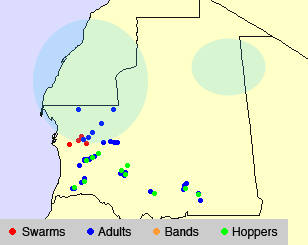
Groups of adults are laying eggs in Inchiri, while there are unconfirmed reports of adults groups in central and northern Mauritania. Rains (blue) fell last month in Western Sahara and northeast Mauritania.
5 October. Mature swarm in northwest Mauritania
A small swarm was seen today near Bennichab (1932N/1512W) in northwest Mauritania consisting of mature gregarious adults, some of which were laying eggs. Local teams are checking the area.
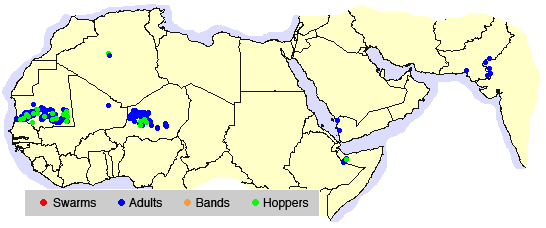
Control operations were undertaken on a farm in central Algeria. Small-scale breeding (green) continues in the Sahel in West Africa. Solitarious adults (blue) are present there as well as on the Red Sea coast, in NW Somalia and along the Indo-Pakistan border.
2 October. Breeding in West Africa continues but locust numbers remain low
Small-scale breeding continues in the Sahel of West Africa in southern and central Mauritania, the Tamesna Plains in Niger and probably in northern Mali. Summer rains may be coming to an end in some of these areas. Consequently locusts could concentrate in those places that remain green and there is a slight risk of small local outbreaks developing. As conditions dry out in the Sahel, low numbers of adults will most likely move to NW and N Mauritania, and to the Western Sahara where good rains fell recently. Limited control operations were conducted against small hopper and adult infestations that persisted in irrigated areas near Adrar in central Algeria. No locusts have been seen during surveys in a portion of the summer breeding areas in Sudan and Eritrea. Isolated adults are present on the Red Sea coast in Yemen and southwest Saudi Arabia. As good rains have fallen on both sides of the Red Sea, additional locusts should arrive there shortly and breed on a small scale. Although the monsoon rains have finished along the Indo-Pakistan border and only scattered adults are present, limited breeding could still occur in areas that were flooded in August.

Control operations were undertaken on a farm in central Algeria. Small-scale breeding (green) continues in the Sahel in West Africa. Solitarious adults (blue) are present there as well as on the Red Sea coast, in NW Somalia and along the Indo-Pakistan border.
4 September. Breeding in West Africa; heavy rains in several areas
Small-scale breeding is underway in Mauritania by solitarious adults in the south and the centre where low numbers of solitarious hoppers have been reported. Low numbers of solitarious adults are also present in the Air Mountains and the Tamesna Plains in Niger, and probably in northern Mali as well. So far, breeding has not been detected but has probably already commenced in both countries because of good rainfall recently in most areas. In northwest Libya, ground control teams treated small infestations of hoppers mixed with groups of adults. Heavy rains and flooding occurred last month in Ethiopia (Dire Dawa), on the southern coastal plains of the Red Sea in Saudi Arabia (Jizan) and along the Indo-Pakistan border (Rajasthan, India and Tharparkar, Pakistan) that will allow breeding conditions to remain favourable for several months. Although solitarious populations are only present in Rajasthan and Tharparkar at the moment, there is a slight risk that small outbreaks may develop by mid-October there as well as in the Sahel and near Jizan in Saudi Arabia.
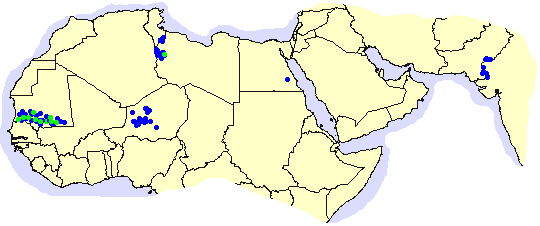
Control operations were undertaken against small-scale breeding (green) in NW Libya. Solitarious adults (blue) are present in the Sahel of West Africa and along the Indo-Pakistan border. Breeding so far has only started in Mauritania.
2 August. Locusts present in the summer breeding areas where good rains have fallen
Solitarious adults are present in parts of the summer breeding areas in the Sahel of West Africa in southern Mauritania and northern Niger and Mali. Adults are also present along the Indo-Pakistan border. Good rains have fallen in most of these areas and small-scale breeding in August will cause locusts to increase slightly. A similar situation is expected in Sudan. Elsewhere, isolated adults are present in southern Egypt and northern Somalia. Ground control operations were undertaken against small infestations on farms near Adrar, Algeria.
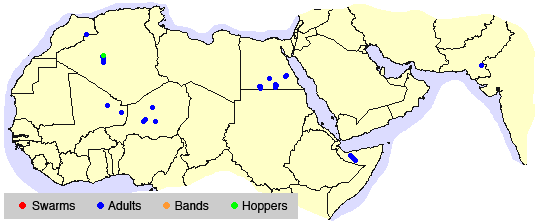
Control operations were undertaken against small-scale breeding (green) in agricultural areas in central Algeria. Solitarious adults (blue) are present in the Sahel, southern Egypt, northeast Africa and along the Indo-Pakistan border.
3 July. Local breeding and control in Algeria and Libya
Small groups of hoppers and adults have developed in Algeria and Libya as a result of local breeding during this past spring. Although ground control operations have been carried out in both countries, continued vigilance is required. Rains have started in a few places in the Sahel where small-scale breeding is expected to occur this summer in Mauritania, Mali, Niger and Sudan. So far, only isolated adults have been reported in Niger but similar numbers are likely to be present in southern Mauritania and northern Mali. Local breeding occurred in northwest Somalia and a few adults are present in southern Egypt. So far, monsoon rains have been poor along the Indo-Pakistan border which may limit summer breeding this year.
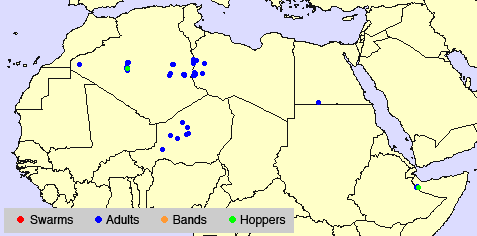
Control operations were undertaken against small-scale breeding (green) in central and eastern Algeria and western Libya. Solitarious adults (blue) are present in the Sahel and in northeast Africa.
5 June. Local breeding and control in Algeria
Locust numbers have increased slightly but remain below threatening levels in central and eastern Algeria as a result of local breeding. Ground control teams treated nearly 4,000 ha in the past few weeks. Elsewhere, no significant infestations have been reported and dry conditions prevailed. In the coming weeks, low numbers of adults are likely to start appearing in the summer breeding areas in the northern Sahel in West Africa and Sudan as well as along the Indo-Pakistan border. Small-scale breeding will occur once the summer rains commence.
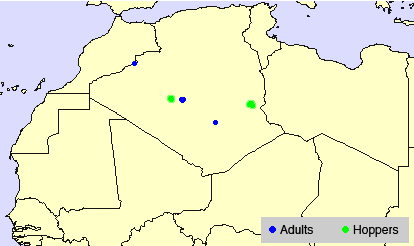
Small-scale breeding (green) has occurred in central and eastern Algeria. Solitarious adults (blue) are present there as well as near the Moroccan border.
2 May. Local breeding continues in NW Africa but situation remains calm
Local breeding is in progress in a few places in NW Africa. In NW Mauritania, low numbers of solitarious hoppers are present. South of the Atlas Mountains in Morocco, hatching is expected this week near the border with Algeria. In the eastern Sahara in Algeria, ground teams treated 20 ha of hoppers. Isolated adults are present in northern Mauritania and Mali. Unless further rains fall, adults will eventually start to move towards the summer breeding areas in the northern Sahel during May and June. The scale of this movement will be very limited. Elsewhere, ecological conditions are dry and no locusts have been reported. Nevertheless, some locusts are likely to be present and may be breeding in Yemen where unusually good rains fell in early April. No significant developments are expected in the coming weeks.

Small-scale breeding (green) is in progress in NW Mauritania, Morocco, and E Algeria. Solitarious adults (blue) are present in N Mauritania and N Mali.
3 April. Local breeding in progress as situation remains calm
Small-scale localized breeding by solitarious adults is in progress in northwest and northern Mauritania, eastern Algeria and southwest Libya. Limited ground control operations were conducted in Algeria and Libya but have not been necessary so far in Mauritania. Although breeding is likely to continue in the three countries during the coming weeks, locust numbers will remain low and should not threaten agricultural crops. Locusts declined in winter breeding areas along the Red Sea coast in Sudan where only a few isolated adults remain in the Tokar Delta. There is a possibility that scattered locusts are present along parts of the Red Sea coast in Yemen where good rain has fallen in the past few days. A 30-day joint Iran/Pakistan survey is underway in the spring breeding areas of Baluchistan in both countries where low numbers of adults could be present and breeding.

Solitarious adults (blue) are present and small-scale breeding (green) is in progress in Mauritania, eastern Algeria and southwest Libya. Few adults remain on the Red Sea coast in Sudan.
2 March 2006. Small infestations persist as situation remains calm
An increasing number of small infestations of solitarious adults have been found in northwest and northern Mauritania. Localized breeding is in progress in one place in the northwest near Nouadhibou and Western Sahara. Locust numbers are likely to increase slightly in these areas during the coming weeks if breeding occurs. Isolated adults are present in southwest Libya and near Lake Nasser in Egypt. In the winter breeding areas along the Red Sea coast, only scattered adults are present in the Tokar Delta of Sudan and along the coast to Suakin. Scattered adults are also present on the coast in northwest Somalia. No significant developments are likely during March.
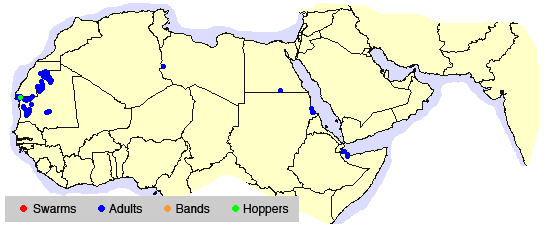
Solitarious adults (blue) are present in Mauritania, southwest Libya, southern Egypt, on the Red Sea coast in Sudan and in northwest Somalia. Small-scale breeding (green) is in progress in northwest Mauritania.
1 February. Small infestations in winter breeding areas
Breeding activity has declined in the past few weeks in the central Mauritania, the Tamesna Plains in Niger and in the Tokar Delta on the Red Sea coast in Sudan. Consequently, only low numbers of late instar solitarious hoppers and adults are present in these areas. Scattered adults are also present in a few places in northern Mauritania and in northeast Sudan. Limited breeding will probably continue on the Red Sea coast during February and is likely to commence in western Pakistan by early March. There is a low probability of small-scale breeding in northwest and northern Mauritania and the chance of a few locusts persisting in northern Mali. Low temperatures in both areas are expected to delay locust maturation. No significant developments are likely and the situation is expected to remain calm in all countries during February.
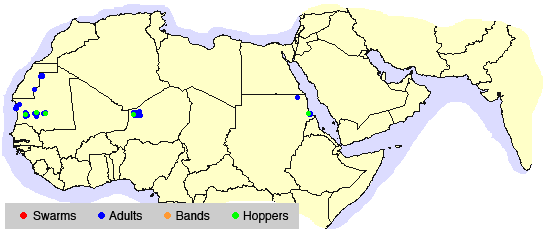
Solitarious adults (blue) are present in Mauritania, Niger and Sudan where small-scale breeding (green) is declining.
23 January. Limited breeding is in progress in the winter breeding areas.
Limited breeding is in progress in the winter breeding areas along the Red Sea coast inTokar Delta, Sudan, and on the northern Tihama coast in Yemen. Small-scale breeding continues in western Mauritania and southern Algeria. Ground control operations have been conducted in both countries against hoppers and adults. Scattered adults are present in a few places in Tamesna, Niger and near two farms in southern Egypt. Small- scale breeding is expected to commence in the coming weeks in northern Mauritania and Western Sahara where good rain fell in December. Control operations against swarms on the Indo-Pakistan border have ended and only low numbers of solitarious adults moved from there to coastal areas in Baluchistan, western Pakistan. These adults will eventually breed if rains fall.
